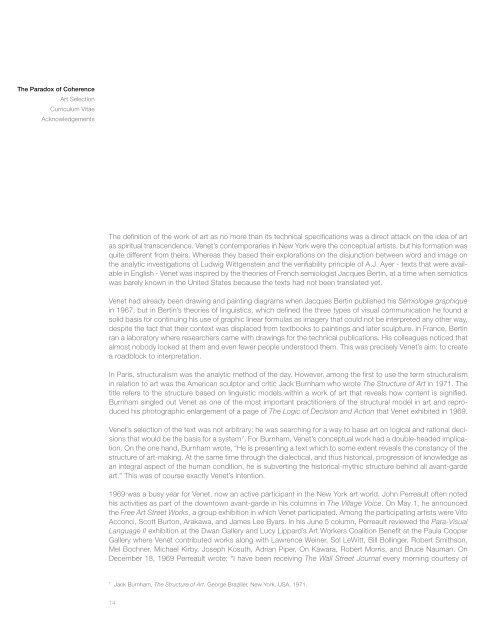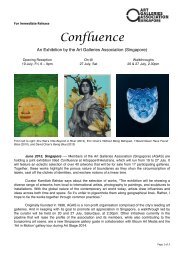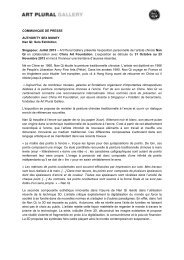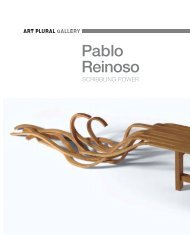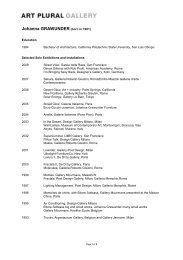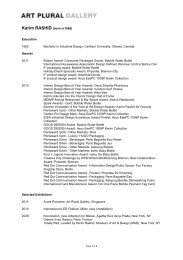Bernar Venet - Art Plural Gallery
Bernar Venet - Art Plural Gallery
Bernar Venet - Art Plural Gallery
You also want an ePaper? Increase the reach of your titles
YUMPU automatically turns print PDFs into web optimized ePapers that Google loves.
The Paradox of Coherence<br />
<strong>Art</strong> Selection<br />
Curriculum Vitae<br />
Acknowledgements<br />
The definition of the work of art as no more than its technical specifications was a direct attack on the idea of art<br />
as spiritual transcendence. <strong>Venet</strong>’s contemporaries in New York were the conceptual artists, but his formation was<br />
quite different from theirs. Whereas they based their explorations on the disjunction between word and image on<br />
the analytic investigations of Ludwig Wittgenstein and the verifiability principle of A.J. Ayer - texts that were available<br />
in English - <strong>Venet</strong> was inspired by the theories of French semiologist Jacques Bertin, at a time when semiotics<br />
was barely known in the United States because the texts had not been translated yet.<br />
<strong>Venet</strong> had already been drawing and painting diagrams when Jacques Bertin published his Sémiologie graphique<br />
in 1967, but in Bertin’s theories of linguistics, which defined the three types of visual communication he found a<br />
solid basis for continuing his use of graphic linear formulas as imagery that could not be interpreted any other way,<br />
despite the fact that their context was displaced from textbooks to paintings and later sculpture. In France, Bertin<br />
ran a laboratory where researchers came with drawings for the technical publications. His colleagues noticed that<br />
almost nobody looked at them and even fewer people understood them. This was precisely <strong>Venet</strong>’s aim: to create<br />
a roadblock to interpretation.<br />
In Paris, structuralism was the analytic method of the day. However, among the first to use the term structuralism<br />
in relation to art was the American sculptor and critic Jack Burnham who wrote The Structure of <strong>Art</strong> in 1971. The<br />
title refers to the structure based on linguistic models within a work of art that reveals how content is signified.<br />
Burnham singled out <strong>Venet</strong> as one of the most important practitioners of the structural model in art and reproduced<br />
his photographic enlargement of a page of The Logic of Decision and Action that <strong>Venet</strong> exhibited in 1969.<br />
<strong>Venet</strong>’s selection of the text was not arbitrary: he was searching for a way to base art on logical and rational decisions<br />
that would be the basis for a system 7 . For Burnham, <strong>Venet</strong>’s conceptual work had a double-headed implication.<br />
On the one hand, Burnham wrote, “He is presenting a text which to some extent reveals the constancy of the<br />
structure of art-making. At the same time through the dialectical, and thus historical, progression of knowledge as<br />
an integral aspect of the human condition, he is subverting the historical-mythic structure behind all avant-garde<br />
art.” This was of course exactly <strong>Venet</strong>’s intention.<br />
1969 was a busy year for <strong>Venet</strong>, now an active participant in the New York art world. John Perreault often noted<br />
his activities as part of the downtown avant-garde in his columns in The Village Voice. On May 1, he announced<br />
the Free <strong>Art</strong> Street Works, a group exhibition in which <strong>Venet</strong> participated. Among the participating artists were Vito<br />
Acconci, Scott Burton, Arakawa, and James Lee Byars. In his June 5 column, Perreault reviewed the Para-Visual<br />
Language II exhibition at the Dwan <strong>Gallery</strong> and Lucy Lippard’s <strong>Art</strong> Workers Coalition Benefit at the Paula Cooper<br />
<strong>Gallery</strong> where <strong>Venet</strong> contributed works along with Lawrence Weiner, Sol LeWitt, Bill Bollinger, Robert Smithson,<br />
Mel Bochner, Michael Kirby, Joseph Kosuth, Adrian Piper, On Kawara, Robert Morris, and Bruce Nauman. On<br />
December 18, 1969 Perreault wrote: “I have been receiving The Wall Street Journal every morning courtesy of<br />
7 Jack Burnham, The Structure of <strong>Art</strong>. George Braziller, New York, USA, 1971.<br />
Paintings, 1976-1978, acrylic on canvas<br />
Exhibition: Institut Valencià d’<strong>Art</strong> Modern (IVAM), Valencia, Spain, 2010<br />
14 15


